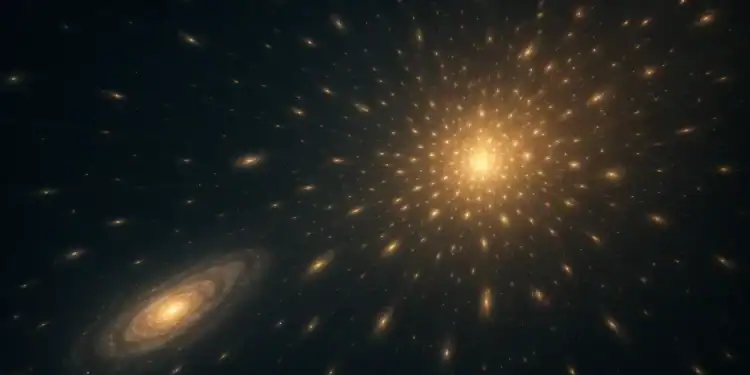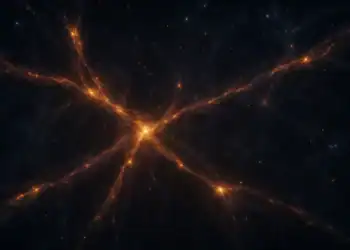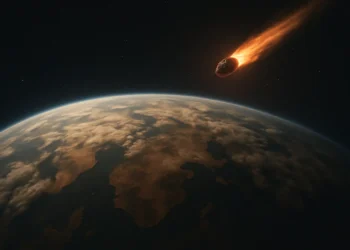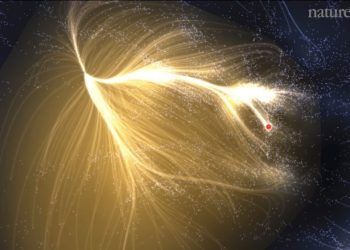We are not floating through space. We are falling into something we cannot see. The Milky Way, along with tens of thousands of other galaxies, is moving at a speed of more than two million kilometers per hour. This motion is not random, and it is not explained by the general expansion of the universe. It has a direction. That direction leads toward a region near Hydra and Centaurus, buried behind the stars and dust of our own galactic plane.
The force behind this movement remains invisible. But the effect is measurable. It pulls on the Local Group, on the Virgo Cluster, and on vast portions of the sky. For now, astronomers call it the Great Attractor. What it is remains unknown.
The cosmic flow: how we discovered we’re moving
In the early twentieth century, the redshift in galaxy light told astronomers that the universe was expanding. Galaxies were drifting away from one another as space itself grew between them. That expansion was expected to be smooth and consistent. But it wasn’t.
In the decades that followed, researchers began to notice irregularities in the velocities of galaxies. Some had additional motion, superimposed on the expansion. These deviations suggested the presence of gravitational influences on scales larger than previously considered.
By the 1970s, scientists turned their attention to the motion of the Milky Way itself. It wasn’t only moving outward with the universe. It was drifting laterally, at high speed, toward a specific region in the southern sky. That direction pointed to a zone that could not be observed with optical instruments, blocked by the dense plane of the galaxy.
The motion was confirmed by observations of the cosmic microwave background. Satellites detected a small but consistent temperature shift across the sky. The radiation was slightly warmer in the direction of motion, slightly cooler in the opposite. This pattern showed that the Milky Way, along with the rest of the Local Group, was being pulled by something massive and unseen.
That same gravitational flow included the Virgo Cluster and dozens of neighboring galaxy groups. The source was not an object but a direction. The pull was real, however the origin remained hidden. So, what in the name of the universe is this Great Attractor?
What is the Great Attractor?
The Great Attractor is not an object. It is a gravitational anomaly located approximately 150 to 250 million light-years away. It lies within a region of the Laniakea Supercluster, which includes the Milky Way and more than one hundred thousand other galaxies.
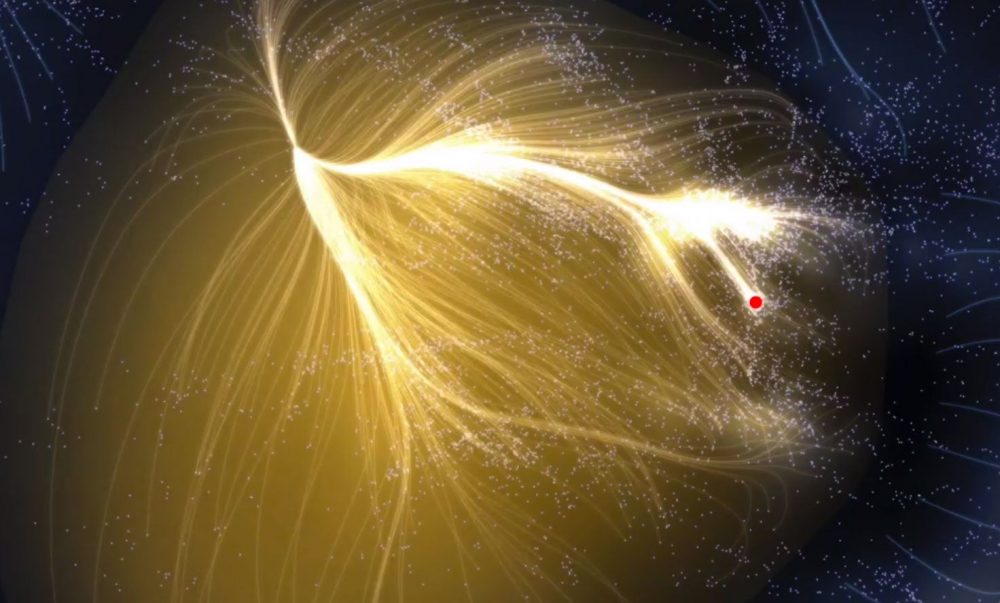
Despite its influence, the Great Attractor has never been seen directly. Its location places it behind the dense band of stars, dust, and gas that make up the plane of our galaxy. This region blocks visible light, making observation with traditional optical telescopes impossible. The area has long been known as the Zone of Avoidance.
To investigate the Great Attractor, scientists rely on indirect evidence. They track the motion of galaxies across large distances and analyze how those movements deviate from simple expansion. These deviations suggest a powerful gravitational pull centered in the hidden region.
Estimates of the mass involved vary, but some place it in the range of tens of thousands of Milky Way’s. That mass appears to be distributed across multiple galaxy clusters, forming part of a larger structure. Despite years of study, no central object has been identified that fully accounts for the scale of its influence.
Dark matter and the hidden structure of the universe
One explanation for the Great Attractor’s pull is the presence of dark matter. Dark matter does not emit or absorb light. It cannot be seen with any telescope. Yet its presence is inferred through gravity. Galaxies rotate faster than visible mass alone can explain. Their motions, especially on large scales, show that something unseen is exerting influence.
The Great Attractor may be a region where dark matter is densely concentrated. Its gravitational effect, visible in the flow of galaxies, could reflect the presence of an enormous volume of matter that does not interact with light.
In 2014, researchers redrew the map of our galactic neighborhood using velocity data. By tracing how galaxies moved through space, they defined the borders of a supercluster now known as Laniakea. At its center lies the region of the Great Attractor. Flow lines from thousands of galaxies converge toward this zone. The paths resemble rivers meeting in a basin. That basin appears to be shaped by a gravitational depression created by mass, most of which remains unseen.
The universe is not evenly filled. It contains long strands of matter called filaments, which connect dense nodes made of galaxy clusters. Between those filaments lie voids, vast expanses with few galaxies at all. The Great Attractor sits at one of these intersections, where multiple filaments converge. It may be a gravitational sink that collects galaxies over hundreds of millions of years.
Is the Great Attractor just a waypoint?
The more researchers have learned about the Great Attractor, the more complex the picture has become. Further out in the same general direction lies another massive structure, the Shapley Supercluster. Located more than 650 million light-years from Earth, Shapley contains many times the mass of the Great Attractor and is one of the densest concentrations of galaxies ever discovered.
Some astronomers now believe the Shapley Supercluster may be influencing the motion of the Great Attractor itself. If that is true, then the pull we experience may not come from a single gravitational center. Instead, it could be part of a larger cascade, with structures pulling on each other across immense distances.
The idea is supported by observations of what scientists call bulk flow. Measurements of galaxy clusters suggest that entire regions of the universe may be moving in a consistent direction, possibly influenced by matter that lies beyond the visible edge of the cosmos. If these observations hold, the Great Attractor may be just one part of a much longer chain of gravitational influence stretching well past the reach of current instruments.
The structure of the cosmos is not random
On the scale of superclusters, the universe begins to show structure. Galaxies do not float alone. They group together in clusters. Those clusters line up along filaments that weave through space. These filaments connect at nodes, forming an interconnected network. Between them lie enormous voids, nearly empty regions that can stretch for hundreds of millions of light-years.
The Great Attractor occupies one of those nodes. Its gravitational influence helps define the motion of the galaxies around it. By studying how matter flows toward the region, scientists can map the density of both visible and dark matter. These studies provide insight into how the universe formed, how it evolved, and how gravity continues to shape it on the largest scales.
The Milky Way is part of this structure. It is not traveling through space alone. It moves with its neighbors, drawn by forces that stretch far beyond the edge of our local cluster. The pull is steady and directional. It reveals a universe that is dynamic, structured, and shaped by mass we cannot yet see.
Can we ever see the Great Attractor clearly?
The Zone of Avoidance has hidden the region of the Great Attractor for decades. Its thick layers of dust and gas block visible light, making standard observation methods useless. But new tools are beginning to change that.
Radio and infrared telescopes can peer through the dust. The Parkes Observatory in Australia has already identified previously unknown galaxies in the hidden zone. The Atacama Large Millimeter Array in Chile, and the upcoming Square Kilometre Array, are expected to reveal even more.
Other techniques include gravitational lensing. This method looks for distortions in the light of distant objects, caused by the gravitational pull of unseen mass between the object and the observer. These distortions can help identify dense regions even when no light is visible.
Redshift surveys, which map the speed and direction of galaxies, are growing more detailed. Combined with advanced computer simulations, these data sets allow scientists to reconstruct the flow of galaxies across space. These reconstructions may eventually uncover the full structure of the Great Attractor, or show that it is part of something even larger.
The universe is still pulling secrets from the dark
The Great Attractor has shaped the motion of our galaxy for millions of years. It is close by, in cosmic terms. Yet it remains hidden, not because it is far away, but because it lies behind the crowded foreground of our own sky.
The pull is real. It has been measured from multiple directions. Our galaxy is not moving aimlessly. It is falling into something vast, dense, and still unseen.
The more we study the Great Attractor, the more we learn about how the universe is built. We are just beginning to understand the structures that guide the motion of galaxies across space. The Great Attractor is one of those structures. But it may not be the last. There may be others beyond it, pulling just as hard, across distances we have not yet reached. We know where we are going. But we still don’t know what lies at the end of the path.



